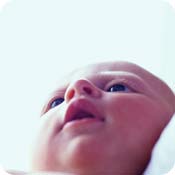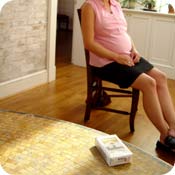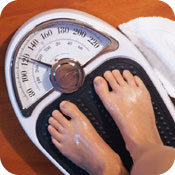 Soft as a baby's butt.
Soft as a baby's butt.
We've all heard that phrase, and it's true that baby's skin is silky smooth - most of the time. Some of the time, a baby's skin can be rashy or scaly. And it's also true silky perfection often is easily irritated.
Time, air or water, with a little nonallergenic soap, will solve most problems.
A disclaimer: My expertise--or rather, my experience--is with basic, run of the mill skin problems in infants and toddlers. You should talk to your pediatrician about persistent irritation or anything that seems to be causing your child discomfort.
Also, I have offered natural remedies whenever possible, but I'm also telling you what easily obtained, drugstore items have helped. Like so many products these days--BPA in baby bottles, anyone?--some of these items contain ingredients that you might not want to use on your baby's skin. Desitin, for example, is a miracle compound for warding off diaper rash but contains ingredients that, according to the Environmental Working Group, might disrupt endocrine activities. I've done the research I can and talked with my pediatrician before choosing to use these products. I'd recommend you do the same. The cosmetics database from Environmental Working Group, a nonprofit dedicated to public health, is a good place to start--for your own skin products, too.
So, without further fuss, here's what's making your baby's skin less than perfect and how to fix it:
- Baby acne: Tiny red or white bumps on your baby's cheeks, chin or forehead. Usually occurring around the one-month mark.
The cure: Time. Left alone, baby acne will disappear. Don't pinch or scratch the bumps. If they last more than three months, the Mayo Clinic recommends checking with your pediatrician.
- Cradle cap: Greasy, scaly yellowish layer on the baby's scalp.
The cure: Time. Usually cradle cap will go away on its own. If it bothers you--it did me--there are a few things you can try: gently scrubbing the baby's scalp or brushing it with a soft brush. A little oil--olive oil will work--will loosen the scales to help this process. But go easy on the baby shampoo; it can make the issue worse.If it's really excessive or really bothering you talk to your pediatrician. She might recommend a prescription dandruff shampoo.
- Dry skin: Patches of rough, dry skin.
The cure: Start by letting your kid be a little dirty. Believe it or not, everyday baths can dry out sensitive baby skin. Baths every other day or even every third day for the littlest babies can help keep skin soft, and really, what are these tiny ones doing to get dirty? Fragrance-free lotions (Aveeno and Burt's Bees are our go-to brands) or natural oils (I've used olive or coconut oil in a pinch) rubbed into the dry spot might clear it up. If it doesn't go away on it's one or looks especially irritated, check with your doctor. It might be an allergic reaction or eczema.
- Diaper rash: Redness and other irritation that can include raised welts, bumps and even open sores.
The cure: Air. At the first sign of diaper rash, let your baby run naked. You probably will end up cleaning up pee, but trust me, it's worth it. No child with a sore rear-end is pleasant. Warm washcloths instead of disposable wipes are gentler and less likely to exacerbate the problem. Tepid baths will help. In our house, we also start slathering on Desitin. A friend who has kids with amazingly sensitive skin gave me this tip from her pediatrician and it works: Smear on the Desitin like cream cheese on a bagel at every diaper change. If that doesn't kill it, think about what's causing it. Run of the mill diaper rash happens because the kiddo sat in pee or poo too long. A more lingering rash might mean a food allergy (or just too much of a good thing, like strawberries,) an illness, cutting teeth or an adverse reaction to medication. Antibiotics especially will wreak havoc on baby's bottom. You can change your baby's diet or talk to your doctor about the other things. Finally, if it's really lingering, take a good look: Are there bumps? It might be a yeast infection. Talk to your doctor, who can prescribe an ointment to help. (We've had this happen with our oldest son, but not our littlest one yet.)
- Chapped skin: Irritated, red, dry skin often around the nose or mouth.
The cure: Air and time. Chapped skin easily gets out of hand in kids because they start licking the affected area. Don't let them do this. The best way to prevent it is to treat the chapped area for them. Slather on some lip balm. Burt's Bees and Aveeno are my favorites, and I put barely any on my preschooler because I don't want him eating it off his lips. My mother swears by Vaseline (a thin layer over the skin) in wintertime.
- Heat rash: Fine red or clear bumps on the skin, often with flushing.
The cure: Time, fewer clothes and maybe cold water. Dress your child in lightweight, light-colored clothes to help prevent heat rash. Layers that can be taken off help. (For what it's worth, I live in Florida and have never had to deal with a heat rash that couldn't be fixed with a little naked time.)
- Sunburn: Reddening of the skin, possibly with heat emanating.
The cure: Prevention. Put a hat on that baby. Keep him covered in lightweight, light-colored clothes. Find a sunscreen with good UVA/UVB protection and apply it every morning and multiple times a day if you're outside. (I like Baby Lizard, which comes recommended from my pediatrician and has a good, not-great score from EWG's sunscreen guide.) If all that fails and your child still gets burned, aloe vera gel will help ease the sting. Give them lots of fluid, because they might be dehydrated. Tepid showers and baths help, too.
- Mystery rash #1: Flat, raised red or pink rash all over torso and face
Likely cause: roseola
The cure: Time. Roseola, or sixth's disease, is a common viral illness that causes fever, fussiness and, toward the end of the illness, a distinctive rash. Usually, by the time the rash occurs, the child is over the worst of the illness. You've probably already called the doctor about his fever, but it might be worth a call just to get the official diagnosis.
- Mystery rash #2: Blisters or sores, sometimes weeping, on the face or hands.
Likely cause: Impetigo
The cure: Soap and water. Impetigo is caused by bacteria that gets under the skin, so it usually occurs after another irritation, such as chapping or scratching of a rash. The best cure is prevention through good hygiene.
I hope this list helps you! And remember: When in doubt, call the pediatrician--or your mom!
|
 Soft as a baby's butt.
Soft as a baby's butt.





Member Comments